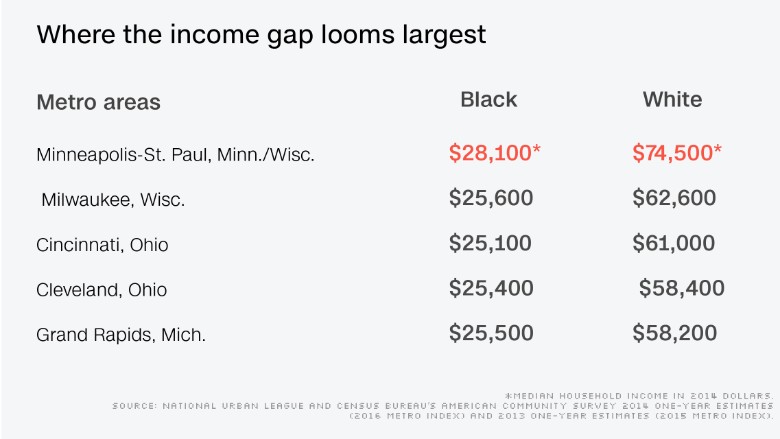
Across America, blacks and Hispanics continue to lag behind whites in key economic areas, including household income and unemployment rates. But in some regions, the gap is far wider than in others, a new report by the National Urban League finds.
Released Tuesday, the report, called The State of Black America, examined economic data for 70 metro areas for blacks and 73 for Hispanics and found that there were no regions in the United States where blacks were more likely to be employed or make more money than whites.
Like blacks, Hispanics in all regions were consistently paid less than whites though, on average, the gaps between white household income and Hispanic household income were smaller than those between whites and blacks, the report found.
"This is the remaining issue of civil rights and economic justice in America," said Marc H. Morial, president and chief executive of the National Urban League. "This economic gap between blacks and whites, which is a component of the gap between rich and poor and working class people in America is a continuing problem."
Nationwide in 2015, 6.6% of Hispanics and 9.6% of blacks were unemployed compared with 4.6% of whites, the National Urban League reported.
But in certain regions, the differences are much more stark.
The metro area with the biggest gap in unemployment between blacks and whites was Milwaukee, where 17.3% of blacks were unemployed compared to 4.3% of whites.
On the opposite side of the spectrum, the regions with the smallest unemployment gaps between blacks and whites included the Providence, Rhode Island metro area, where 9.9% of blacks were unemployed compared to 6.8% of whites. Chattanooga, Tenn. and Greensboro, NC came next and had similar unemployment figures.
Related: Why the racial wealth gap won't go away
Hispanics were more likely to be employed than blacks and were also more likely to have smaller gaps in unemployment compared to whites.
The narrowest gap between the two groups was in the Indianapolis metro area, where whites had a slightly higher unemployment rate at 5.7% than Hispanics at 5.5%. And the metro areas of Cape-Coral-Fort Myers, Florida, Memphis, Tenn., Tulsa, Okla. and St. Louis, Mo., all had unemployment gaps of less than one percentage point between whites and Hispanics.
But in Springfield, Mass., 21.5% of Hispanics were unemployed compared to 6.3% of whites, making it the area with the biggest disparity between whites and Hispanics in the country, the National Urban League reported.

According to the report, in 2014, the median household income for blacks was $35,481, compared to $42,768 for Hispanics and $59,662 for whites.
The largest gap in household income was in the Minneapolis-St. Paul metro area, where whites earned an average of $74,455 -- more than two times the average income of $28,138 for blacks.
The income gap between whites and blacks was smallest in Riverside-San Bernadino, Calif., where blacks averaged $46,438 compared to whites at $60,668.
Related: The retirement crisis facing Hispanics
Yet, like blacks, Hispanics in all of the metro areas were consistently paid less than whites. The largest income gap was in Springfield, Mass., where Hispanics made a median household income of $23,911 compared to the $60,105 whites earned. Behind that, were the regions of Worcester, Mass. and Hartford, Conn.
The smallest income disparity between Hispanics and whites was in Urban Honolulu, Hawaii, where Hispanics had an average household income of $63,815 compared to $79,299 for whites. Rounding out the top five were Riverside-San Bernadino, Calif., Lakeland, Fla., Tampa-St. Petersburg, Fla. and Tulsa, Okla.


